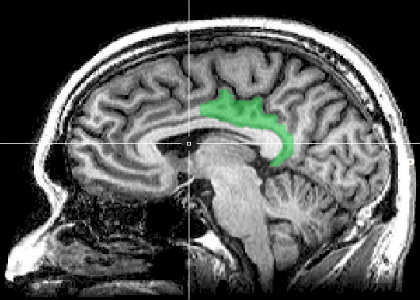Everybody feels pain differently, and brain structure may hold the clue to these differences.
In a study published in the current online issue of the journal Pain, scientists at Wake Forest Baptist Medical Center have shown that the brain’s structure is related to how intensely people perceive pain.
“We found that individual differences in the amount of grey matter in certain regions of the brain are related to how sensitive different people are to pain,” said Robert Coghill, Ph.D., professor of neurobiology and anatomy at Wake Forest Baptist and senior author of the study.

The brain is made up of both grey and white matter. Grey matter processes information much like a computer, while white matter coordinates communications between the different regions of the brain.
The research team investigated the relationship between the amount of grey matter and individual differences in pain sensitivity in 116 healthy volunteers. Pain sensitivity was tested by having participants rate the intensity of their pain when a small spot of skin on their arm or leg was heated to 120 degrees Fahrenheit. After pain sensitivity testing, participants underwent MRI scans that recorded images of their brain structure.
“Subjects with higher pain intensity ratings had less grey matter in brain regions that contribute to internal thoughts and control of attention,” said Nichole Emerson, B.S., a graduate student in the Coghill lab and first author of the study. These regions include the posterior cingulate cortex, precuneus and areas of the posterior parietal cortex, she said.
The posterior cingulate cortex and precuneus are part of the default mode network, a set of connected brain regions that are associated with the free-flowing thoughts that people have while they are daydreaming.
“Default mode activity may compete with brain activity that generates an experience of pain, such that individuals with high default mode activity would have reduced sensitivity to pain,” Coghill said.
Areas of the posterior parietal cortex play an important role in attention. Individuals who can best keep their attention focused may also be best at keeping pain under control, Coghill said.
“These kinds of structural differences can provide a foundation for the development of better tools for the diagnosis, classification, treatment and even prevention of pain,” he said.
Notes about this neurology and pain research
The study was supported by the National Institutes of Health grants NS039426 and DA020168 and the U.S.-Israel Binational Science Foundation grant 2009097.
Co-authors include Fadel Zeidan, Ph.D., Oleg Lobanov, Ph.D., Morten Hadsel, Ph.D., Katherine Martucci, Ph.D., Alexandre Quevedo, Ph.D., and Christopher Starr, Ph.D., of Wake Forest Baptist; Hadas Nahman-Averbuch, M.S., Yelena Granovsky, Ph.D., and David Yarnitsky, Ph.D., of Technion Faculty of Medicine, Haifa, Israel; and Irit Weissman-Fogel, Ph.D., of University of Haifa.
Contact: Marguerite Beck – Wake Forest Baptist Medical Center
Source: Wake Forest Baptist Medical Center press release
Image Source: The image credited to Geoff B Hall and is in the public domain.
Original Research: Abstract for “From cue to meaning: Brain mechanisms supporting the construction of expectations of pain” by Oleg V. Lobanov, Fadel Zeidan, John G. McHaffie, Robert A. Kraft, and Robert C. Coghill in Pain. Published online September 19 2013 doi:10.1016/j.pain.2013.09.014







